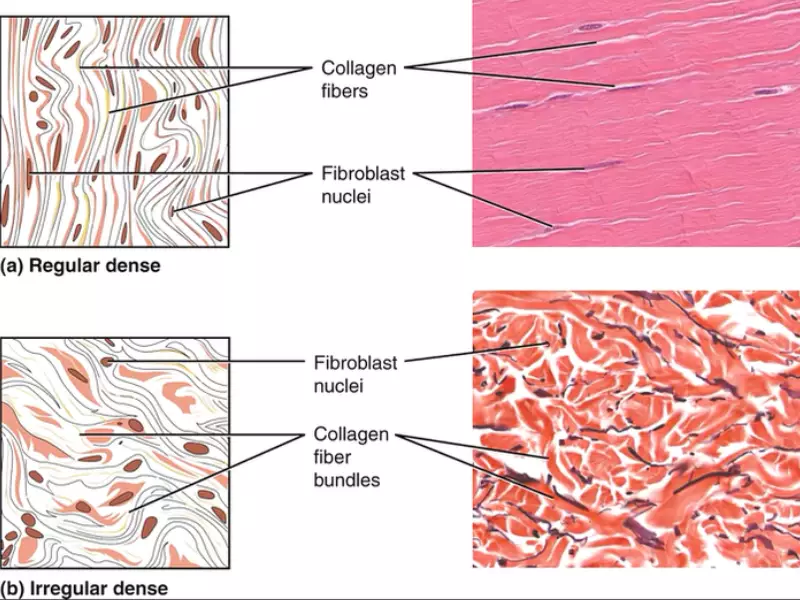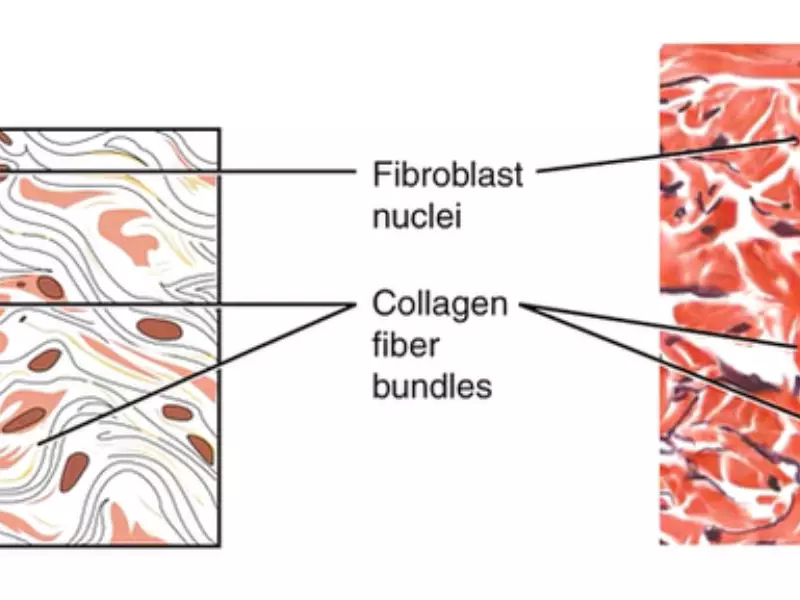Connective tissue serves as the architectural framework of the human body, binding tissues and organs together while providing strength and elasticity. Among its various types, dense connective tissue plays a pivotal role in offering support and protection. It is characterized by its dense arrangement of collagen fibers, but is subdivided into two categories: dense regular and dense irregular connective tissue, each with unique structures and functions.
The primary difference between dense regular and dense irregular connective tissue lies in the alignment of collagen fibers. Dense regular connective tissue showcases parallel collagen fibers, enabling tensile strength in a single direction. This is contrasted by dense irregular connective tissue, where the fibers are arranged in a chaotic manner, providing strength in multiple directions. This structural variation underscores their distinct functional roles within the body.
Dense connective tissues are integral to the body’s functionality, with their distribution and composition tailored to specific needs. Dense regular tissue, for instance, forms tendons and ligaments, facilitating movement and stability. On the other hand, dense irregular tissue reinforces the skin and organ capsules, offering protection against multi-directional forces. The understanding of these tissues’ characteristics is crucial for insights into their roles in health and disease.

Dense Connective Tissue Basics
Definition and Role
Dense connective tissue is a type of connective tissue rich in collagen fibers. These fibers give the tissue its strength and durability, making it an essential component in the body’s structure. The primary role of dense connective tissue is to support and protect various organs, connect muscles to bones (tendons), and bones to bones (ligaments). Additionally, it plays a critical role in transmitting mechanical forces and providing a structural framework that stabilizes the body’s internal structure.
Types: Regular vs Irregular
There are two main types of dense connective tissue: dense regular and dense irregular. The key difference between them lies in the alignment of collagen fibers.
- Dense Regular Connective Tissue: This type features collagen fibers aligned in parallel arrays. This arrangement offers great tensile strength in one direction, making it ideal for structures that bear unidirectional forces.
- Dense Irregular Connective Tissue: In contrast, this type has collagen fibers that are randomly arranged. This configuration provides strength in multiple directions, suitable for areas subjected to forces from various angles.
Dense Regular Connective Tissue
Structure
Dense regular connective tissue is characterized by its organized and linear arrangement of collagen fibers. These fibers are packed closely together, with little ground substance and few cells, mostly fibroblasts, which produce and maintain the collagen fibers. This structured organization results in a white, glistening appearance, often seen in tendons and ligaments.
Function
The main function of dense regular connective tissue is to connect muscles to bones (tendons) and bones to bones (ligaments). It provides a strong, firm attachment facilitating the transfer of muscular force with minimal energy loss. This efficiency is crucial for movement and stability within the skeletal system.
Locations and Examples
- Tendons: These are cord-like structures that attach muscles to bones, enabling movement.
- Ligaments: These connect bones to other bones at joints, providing stability and limiting excessive movement.
Dense Irregular Connective Tissue
Structure
Dense irregular connective tissue is noted for its chaotic, interwoven collagen fibers. This lack of alignment allows the tissue to resist tension from multiple directions. Fibroblasts are scattered among the fibers, contributing to the dense network. The irregular arrangement gives the tissue a less uniform appearance compared to its regular counterpart.
Function
The primary role of dense irregular connective tissue is to provide strength and support to areas subjected to stresses from various directions. It forms a protective layer around organs, preventing overexpansion and damage under mechanical stress.
Locations and Examples
- Dermis of the skin: Offers strength, flexibility, and protection against external forces.
- Fibrous capsules of organs: Such as the liver, kidneys, and lymph nodes, providing structure and protection.
- Periosteum: The outer layer of bones, contributing to bone strength and attachment for muscles and ligaments.
Comparative Analysis
Structural Differences
The structural difference between dense regular and dense irregular connective tissues is primarily in the alignment of collagen fibers. Dense regular’s parallel alignment contrasts with the random, interwoven pattern found in dense irregular tissue. This distinction is not merely cosmetic but fundamentally affects their mechanical properties and functional roles.
Functional Contrast
While both types of dense connective tissue share the common function of providing support and protection, their specific roles differ significantly due to their structure. Dense regular tissue excels in situations where strength is needed in a single direction, such as in tendons and ligaments. Conversely, dense irregular tissue is adept at providing support and resistance in areas where forces are applied from various angles, like the dermis.
Adaptive Significance
The adaptive significance of these tissues lies in their evolutionary optimization for specific roles within the body. The alignment of collagen fibers in dense regular connective tissue provides optimal force transmission along a single axis, crucial for the efficient movement of limbs. Meanwhile, the irregular arrangement in dense irregular tissue offers multidirectional strength, essential for protecting organs and other structures from varied mechanical stresses. This specialization ensures that the body can handle different physical demands efficiently, highlighting the intricate design of the human anatomy.

Factors Influencing Tissue Type
Genetic Factors
The type and structure of connective tissue in the body are significantly influenced by genetic factors. Genes determine the specific types of collagen and other proteins that are synthesized, impacting the strength, elasticity, and overall composition of the tissue. Genetic mutations can lead to abnormalities in collagen production, resulting in various connective tissue disorders. For instance, mutations in the genes responsible for collagen synthesis can cause conditions like Ehlers-Danlos syndrome, characterized by overly flexible joints and stretchy, fragile skin.
Environmental Influences
Environmental factors also play a crucial role in the development and health of dense connective tissues. Physical activity, for example, can enhance the strength and resilience of these tissues. Regular exercise stimulates the production of collagen, improving the tensile strength of tendons and ligaments. Conversely, a sedentary lifestyle may weaken connective tissues, making them more susceptible to injury. Nutritional status is another significant factor, as vitamins and minerals like vitamin C and zinc are vital for collagen synthesis and tissue repair.
Clinical Relevance
Common Disorders
Dense connective tissues are prone to a range of disorders, primarily due to overuse, genetic predispositions, or aging. Tendinitis and ligament sprains are common issues affecting dense regular connective tissue, often resulting from repetitive stress or acute injuries. Conditions such as scleroderma involve dense irregular connective tissue, where excessive collagen deposition leads to skin hardening and can affect internal organs.
Diagnostic Approaches
Diagnosing disorders of dense connective tissue involves a combination of clinical evaluation, imaging studies, and sometimes genetic testing. Physical examination can assess pain, swelling, and range of motion. Imaging techniques like MRI and ultrasound provide detailed views of the tissue structure, helping identify abnormalities in collagen fiber alignment or density. Genetic tests can detect mutations associated with hereditary connective tissue disorders, offering insights into the condition’s prognosis and guiding treatment decisions.
Treatment Strategies
Treatment for dense connective tissue disorders varies depending on the condition’s severity and the tissue affected. Management strategies often include:
- Physical therapy to strengthen the surrounding muscles and improve tissue function.
- Medications, such as anti-inflammatory drugs, to reduce pain and swelling.
- Surgical interventions may be necessary for severe cases, such as repairing torn ligaments or tendons.
- Lifestyle modifications, including dietary changes and exercise routines, can help manage symptoms and prevent further damage.
Research and Innovations
Recent Studies
Recent studies in the field of connective tissue research have focused on understanding the molecular mechanisms underlying tissue repair and regeneration. Innovations in biomaterials and stem cell therapy have shown promise in enhancing the healing of dense connective tissues. For example, research into scaffolds that mimic the natural structure of connective tissue can support the growth of new, healthy tissue in areas of damage. Additionally, studies exploring the use of stem cells to regenerate connective tissue offer hope for more effective treatments for conditions that currently have limited therapeutic options.
Future Directions
Looking ahead, the future of connective tissue research and treatment is geared towards personalized medicine and regenerative therapies. Advances in genetic testing will allow for more tailored approaches to treating connective tissue disorders, based on an individual’s genetic makeup. The development of regenerative therapies, including tissue engineering and stem cell treatments, holds the potential to restore normal function to damaged tissues. Moreover, ongoing research into the environmental and lifestyle factors affecting connective tissue health could lead to preventive strategies that minimize the risk of disorders. The ultimate goal is to enhance the quality of life for individuals affected by connective tissue conditions, through improved diagnostic tools, innovative treatments, and preventive measures.
Frequently Asked Questions
What is Connective Tissue?
Connective tissue is a fundamental tissue type in the body that supports, binds together, and protects organs. It consists of cells, fibers, and ground substance. The diversity in its composition allows it to perform various functions, from providing structural support to facilitating nutrient distribution.
How Does Dense Connective Tissue Differ from Loose Connective Tissue?
Dense connective tissue is characterized by its tightly packed collagen fibers, providing high tensile strength and resistance to stretching. In contrast, loose connective tissue features a less dense arrangement of fibers, offering more flexibility and elasticity. This structural difference influences their functional roles within the body.
Why is the Arrangement of Collagen Fibers Important?
The arrangement of collagen fibers is crucial because it determines the tissue’s strength and flexibility. In dense regular connective tissue, parallel fibers offer strength in one direction, ideal for tendons and ligaments. Conversely, the irregular arrangement in dense irregular tissue provides tensile strength in multiple directions, necessary for areas requiring resilience to various forces, such as the dermis of the skin.
Can Dense Connective Tissue Regenerate After Injury?
The regenerative capacity of dense connective tissue varies. Dense regular connective tissue, such as tendons and ligaments, has a limited blood supply, making its healing process slower and often incomplete. Dense irregular tissue, with a somewhat better blood supply, may heal more effectively but can also form scar tissue, altering its original structure and function.
Conclusion
Dense regular and dense irregular connective tissues play indispensable roles in the human body, each adapted to specific functional requirements through their unique structural compositions. Understanding the differences between these two types of connective tissue not only enlightens us about the intricacies of the human body but also enhances our approach to diagnosing and treating related disorders. Their study reveals the elegance of the body’s design, where even the smallest structural variations can have profound implications for health and functionality.
The insights gained from examining dense connective tissues underscore the importance of detailed anatomical and physiological knowledge. As we continue to explore and understand these fundamental components, we pave the way for advancements in medical science, improving both diagnostic and therapeutic approaches for connective tissue-related conditions. This knowledge empowers us to appreciate the complexity and resilience of the body, encouraging further exploration and discovery in the vast field of biomedical science.
